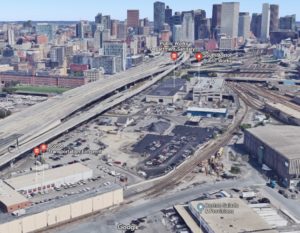
Some Boston city councilors are asking for a robust public debate on how the 18-acre Frontage Road parcels should be developed before the city declares them as surplus property for a potential sale to a private developer. (Photo courtesy of Google)
A professional soccer stadium. A Boston Landing-style combo of housing, offices and retail. A recreated wetland sponging up Boston Harbor storm surges.
What becomes of Boston’s 18-acre Frontage Road parcels – and whether the Boston City Council agrees to sell them at all – will hinge on a looming debate over competing interests including revenues, resiliency and affordable housing.
Some councilors want a robust public discussion before any vote to declare as surplus the low-lying expanses of tow lots and municipal buildings between Interstate 93 and rail lines. The legal step is necessary before the Boston Planning and Development Agency (BPDA) can take ownership and seek proposals from potential buyers.
“Should the council not sell that land, there would be more direct control in terms of what we could do in terms of housing and climate preparedness,” said District 6 Councilor Matt O’Malley, adding that the BPDA has a track record of managing development “fairly well, and not so well in other cases.”
A local environmental group wants the property to be restored as a giant wetland to shield nearby neighborhoods from flooding, along with other parcels being eyed for development in Fort Point and Dorchester Avenue.
Speculation about The Kraft Group’s interest in Frontage Road as a professional soccer stadium continues to hover over the process, given the New England Revolution owners’ years-long search for an urban alternative to Gillette Stadium. Mayor Marty Walsh told the Boston Herald he hasn’t ruled out a stadium on Frontage Road, along with housing and open space. Councilor At-Large Michael Flaherty said he opposes a stadium, as a council committee began to review its options last month.
In an email, spokesman Stacey James said The Kraft Group “continues to seek opportunities,” but declined further comment.
Flood Risks Continue To Rise
The home to the city’s impounded vehicle lot, municipal vehicle maintenance shops and public works highway operations center, Frontage Road is nearing the end of its useful lifespan, according to Walsh administration officials reviewing alternate sites. The estimated cost of replacing the services elsewhere is $150 million, according to materials submitted to councilors in August.
Portions of the site are prone to flooding, according to the Greenovate Boston Climate Action Plan Update released in 2014, necessitating the installation of rooftop solar arrays to provide electricity during outages.

Steve Adams
The site’s vulnerability is no surprise, given its history as a Boston Harbor inlet. Large portions of South Bay were filled during the 19th century to support development. A waterway known as the Bass River that runs beneath the Frontage Road property was diverted into an underground culvert. And a report by Climate Ready Boston projects a more than 3-foot rise in Boston Harbor sea levels by 2070.
The Weston-based Charles River Watershed Assoc. has floated two proposals for the Frontage Road site, including a no-build option that would restore the property as a wetland that could absorb stormwater and harbor flooding. The other proposal would incorporate an unspecified amount of development but exhume the waterway, increasing the site’s capacity to channel stormwater.
District 3 Councilor Frank Baker was skeptical of the group’s suggestions, arguing that private development is needed to subsidize resiliency.
“We do not have the money here to turn this into a wetland or a catch basin or whatever it would be,” Baker said.
The CRWA proposal resembles shore-based resiliency strategies being considered by the Walsh administration for other coastal areas. The Climate Ready South Boston plan released in October would rely on low-lying properties such as Moakley Park on Columbia Road and the eastern side of Fort Point Channel to function as flood-absorbing “living shorelines.”
“The city is thinking about using nature-based solutions,” said Julie Dyer Wood, CRWA’s director of projects. “When you’re thinking about protecting yourself from flood waters, it isn’t just about building a 10-foot-high berm that attempts to block us off from the ocean and makes the city much less desirable.”
In a three-step process proposed by the mayor’s office, the council would transfer the property to the city’s public facilities commission, which would have the power to transfer the property to the BPDA. The BPDA – with has four of its five directors appointed by Walsh – would seek proposals, select a developer and approve the plans following its large project review.
An open-ended request for proposals would enable the city to get the broadest response, said Sara Myerson, the BPDA’s director of planning.
Councilors had limited say over the city’s most recent major surplus property transfer, the former Winthrop Square parking garage. Millennium Partners broke ground this fall on a $1.3-billion office and luxury condo tower, after submitting a high bid of $166 million for the 1-acre property. The 1.6-million-square-foot tower, approved by the BPDA in May, required state legislation to exempt it from Boston Common shadow protection laws and initially exceeded FAA height guidelines.
With the larger acreage on Frontage Road to consider, O’Malley said public hearings should be held before any votes.
“This is unique, and many people feel as an independent, elected body, if we simply sign off this property we are going to lose a lot of leverage to affect something that will be the best in the city,” he said.




 |
| 